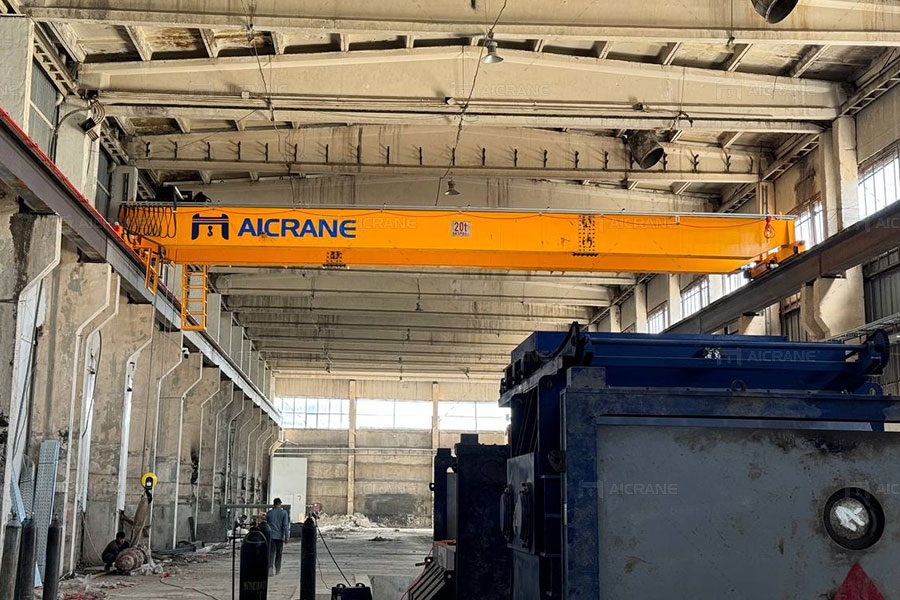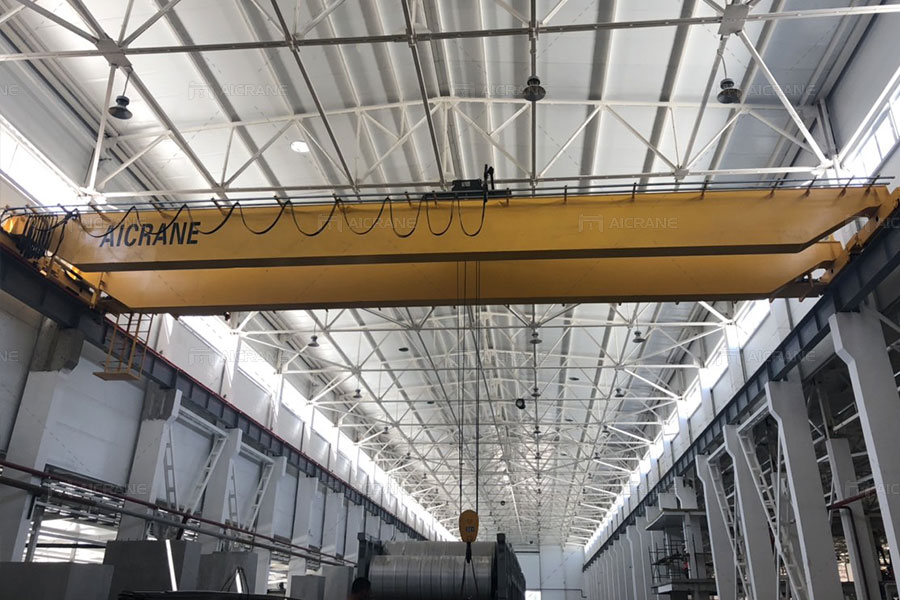Overhead cranes are essential for various industrial applications, providing efficient and reliable lifting solutions for a wide range of tasks. These cranes come in different capacities to handle loads of varying weights. Among these, the 20-50 ton overhead crane range is often used for medium-duty lifting applications, striking a balance between light-duty and heavy-duty operations. This article explores the key features and benefits of 20-50 ton overhead cranes and provides insights into how these cranes can improve efficiency, safety, and overall productivity in various industries.

1. Overview of 20-50 Ton Overhead Cranes
Overhead cranes are designed to lift and transport heavy loads horizontally across a workspace. The 20 ton to 50 ton range falls under medium-duty cranes, typically used in industrial environments that require lifting capabilities beyond those of light-duty cranes but not as heavy as the ones required for massive loads. Industries that commonly use 20 to 50 ton overhead cranes include manufacturing plants, warehouses, construction sites, steel mills, and power stations.
These cranes are highly versatile, capable of handling a variety of materials, including steel, machinery, precast concrete, and other heavy components. Their capacity to move large and heavy loads efficiently is a significant asset, contributing to optimized workflow and reduced manual labor.
2. Key Features of 20-50 Ton Overhead Cranes
a. Load Capacity and Lifting Height
One of the defining features of overhead cranes in the 20-50 ton range is their ability to handle substantial loads while offering optimal lifting height. These cranes are typically capable of lifting materials that weigh anywhere between 20 and 50 tons, making them ideal for medium-duty lifting applications. The lifting height of these cranes can vary, but they are usually designed to handle typical industrial lifting tasks. Depending on the specific model and manufacturer, lifting heights can range from 10 meters to more than 30 meters.
The ability to move heavy loads with ease while maintaining control is crucial, especially in applications like steel manufacturing, precast concrete lifting, and other industries that require precise load movements.

b. Customizable Span and Reach
The span of an overhead crane refers to the width of the crane bridge that spans across the workspace, while the reach refers to the distance from the center of the crane to the furthest point the load can be lifted. For 20 ton overhead crane, 30 ton overhead crane, 40 ton overhead crane and 50 ton overhead crane, the span typically ranges from 10 meters to 30 meters, depending on the requirements of the particular facility.
Customization options for span and reach allow these cranes to be adapted for specific working environments, ensuring maximum efficiency. For instance, cranes used in tight spaces might have a shorter span, while those in large warehouses or outdoor spaces might have a broader span.
c. Durable Construction and Materials
The structure and materials used in 20-50 ton overhead cranes are built for durability and reliability. These cranes typically feature a combination of high-strength steel and other materials designed to withstand the stresses of lifting and moving heavy loads. The bridge girders, hoists, trolley systems, and rails are all designed to support the weight of the materials being transported.
Quality control and materials selection are critical in ensuring the crane can handle the medium-duty lifting demands of industries such as manufacturing, construction, and materials handling. The heavy-duty frame ensures long-term reliability, minimizing downtime and repair costs.
d. Power and Drive Systems
Power and drive systems in overhead cranes play a significant role in their performance. Cranes in the 20-50 ton capacity range typically come equipped with high-performance electric motors and variable-speed drives. These power systems enable smooth and efficient operation, offering precise control over lifting and movement.
The hoist mechanism, which is responsible for lifting loads, is typically powered by an electric motor. The motor’s size and configuration depend on the weight capacity of the crane. Variable frequency drives (VFDs) allow for better control of the crane’s speed and ensure smoother acceleration and deceleration, which is essential for precise operations.

e. Safety Features
Safety is paramount in any lifting operation, and 20-50 ton overhead cranes are equipped with several safety features to ensure both operator and load safety. Some of the key safety features include:
-
Limit Switches and Overload Protection: Limit switches prevent the crane from exceeding its maximum lifting height or traveling beyond the designated operating area. Overload protection ensures the crane does not lift loads beyond its capacity, which can cause damage to the crane and lead to accidents.
-
Emergency Stops: In case of emergencies, industrial overhead cranes are equipped with easily accessible emergency stop buttons, allowing operators to halt crane operation instantly.
-
Anti-Sway Systems: Overhead cranes in this weight range often feature anti-sway mechanisms that reduce the swinging of loads during lifting and movement. These systems ensure precise load placement and help prevent accidents caused by uncontrolled swinging.
-
Safety Interlocks and Sensors: Sensors monitor the crane’s operational parameters, ensuring that the crane is only operated within safe limits. Safety interlocks prevent dangerous operations, such as moving the crane without a properly secured load.
f. Control Systems
Modern 20-50 ton overhead cranes come with advanced control systems, which can include both manual and automated options. The control system consists of a variety of components, including the trolley, hoist, and bridge drives, all of which are integrated into a unified interface for operators.
-
Ground Control: This control system is standard for cranes in the 20-50 ton range, allowing the operator to control the crane from the ground with a remote pendant or wired controller.
-
Radio Remote Control: For improved flexibility and safety, many overhead cranes are equipped with wireless radio remote control systems. These systems allow the operator to control the crane from a distance, ensuring clear visibility of the load and minimizing the risk of accidents.
-
PLC Control: Programmable Logic Controllers (PLCs) are often integrated into the crane’s control system. PLCs provide precise control over crane operations, including speed adjustments, braking systems, and load positioning.
3. Applications of 20-50 Ton Overhead Cranes
Overhead cranes in the 20-50 ton range are widely used in various industries due to their versatility and lifting power. Some common applications include:
-
Manufacturing and Assembly Plants: These cranes are used for lifting heavy machinery, raw materials, and components during assembly and production processes.
-
Steel Mills: Steel mill overhead cranes with a lifting capacity of 20-50 tons are essential for moving steel billets, coils, and other heavy metal products within steel mills and foundries.
-
Construction Sites: Cranes in this range are used on construction sites for moving building materials, precast concrete components, and large equipment.
-
Shipyards: In shipbuilding, cranes of this capacity are used to lift and move heavy components, such as ship sections and engines, during the construction and maintenance of ships.
-
Warehouses and Distribution Centers: 20-50 ton overhead cranes are employed for loading and unloading trucks, moving heavy pallets, or handling large containers.
4. Maintenance and Longevity
Like any heavy-duty equipment, 20-50 ton overhead cranes require regular maintenance to ensure optimal performance and extend their lifespan. Maintenance includes regular inspections, lubrication, checking for wear and tear on key components, and ensuring that the safety systems are functional. Proper maintenance ensures the crane operates smoothly, reduces downtime, and minimizes repair costs.
It is important to develop a scheduled maintenance program that aligns with the crane’s usage frequency and the specific demands of the workplace. Manufacturers often provide maintenance guidelines and service contracts to help businesses keep their cranes in top condition.
5. Conclusion
Overhead cranes with a lifting capacity of 20-50 tons offer an excellent solution for medium-duty lifting applications across a wide range of industries. These cranes combine powerful lifting capabilities with advanced safety features and control systems to enhance operational efficiency and worker safety. When selecting an overhead crane for medium-duty lifting, it is crucial to consider factors such as load capacity, lifting height, span, and safety features to ensure the crane meets the specific needs of your operation.
With proper maintenance, a 20-50 ton overhead crane can provide reliable service for many years, helping businesses optimize their operations, reduce labor costs, and improve overall productivity. Whether used in manufacturing, construction, or logistics, these cranes are an invaluable asset for any company that needs to move heavy materials efficiently and safely.